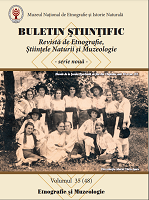Școlile de meserii din Basarabia (sfârșitul sec. XIX - mijlocul sec. XX)
Vocational Schools in Bessarabia (late nineteenth century – mid-twentieth century)
Author(s): Elena MadanSubject(s): Cultural history, Social history, School education, History of Education, State/Government and Education, 19th Century, Pre-WW I & WW I (1900 -1919), Interwar Period (1920 - 1939), WW II and following years (1940 - 1949), Sociology of Education
Published by: Muzeul Național de Etnografie și Istorie Naturală
Keywords: crafts schools; craft classes; masters; craftsmen; crafts; specialized workshops;
Summary/Abstract: Some of the first vocational schools from the end of the 19th century appeared at the initiative of the government and county authorities. The 11th assembly of the Bessarabian Governmental Zemstva in January 1880, decided to create 7 crafts classes, one in each county. Another reason for opening a vocational school was at the request of the locals, such as the vocational school in Mingir, Ismail County (nowadays in the Hancesti district), opened in 1889 and supported by the then Ministry of Education. It should be mentioned that until 1896 only in Hotin County were opened 17 public classes of carpentry, shoemaking, tailoring. From 1914 onwards, in every county in Bessarabia, except Ismail, there were craft classes. The vocational schools in Bessarabia failed to cover the technical needs of the peasant households in the counties, so the Bessarabian socio-economic system did not benefit enough from their activity. Many of those who worked in the specialized workshops did not have the vocational school, and the learning of the profession was taken from father to son or others being apprentices to a local craftsman; this knowledge gained by future craftsmen although not official they should also be seen as schools of crafts.
Journal: Buletin Științific. Revistă de Etnografie, Științele Naturii și Muzeologie
- Issue Year: 35/2021
- Issue No: 35
- Page Range: 140-147
- Page Count: 8
- Language: Romanian

